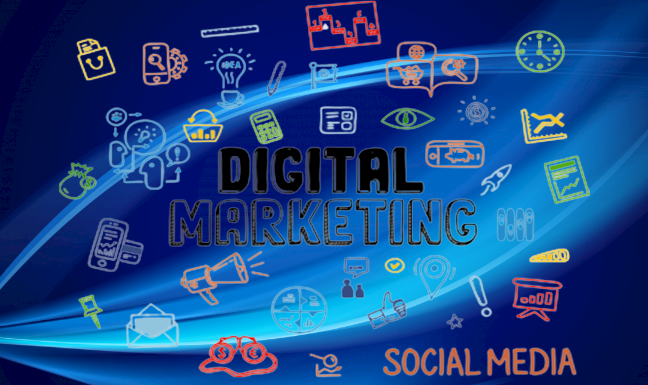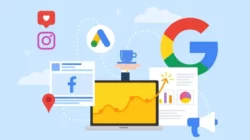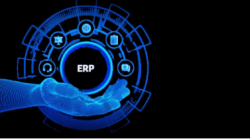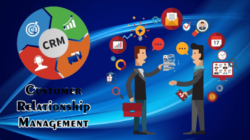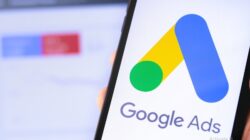Every market uses digital marketing that marketers can use to deliver promotional messages and measure their impact throughout your customer journey. In practice, digital marketing usually refers to marketing campaigns that appear on a computer, phone, tablet or other device. This can take many forms, including online video, display advertising, engine marketing, paid social media, and social media. Digital marketing is often compared to “traditional marketing” such as magazine ads, billboards, and direct mail. Ironically, television is often associated with traditional marketing.
Did you know that more than a third of Americans connect to the Internet every day? Not only that, but 43% go online more than once a day and 26% are online “almost all the time”.
These numbers are even higher among mobile users. 89% of Americans go online at least daily and 31% are online often. As a marketer, it is important to take advantage of the digital world and online media, build a brand, provide a great customer experience that also brings more potential customers, and digital strategy.
A digital marketing strategy allows you to manage various digital channels, such as social media, pay-per-click, search engine optimization, and email marketing, to connect with existing customers and new customers. . people who are interested in your product or service. As a result, you can build a brand, provide an exceptional customer experience, attract potential customers, and more.
What is Digital Marketing?
Digital marketing also known as online marketing, is the promotion of brands to connect with potential customers using the Internet and other forms of digital communication. This includes not only email, social media and web advertising, but also text and social media such as marketing channels.
In fact, if marketing involves digital communication, it is digital marketing. Inbound Marketing vs. Digital Marketing
Digital marketing and inbound marketing are easily confused, and for good reason. Digital marketing uses many tools like inbound marketing – email and online content, to name a few. Both exist to capture the attention of prospects during the buyer’s journey and turn them into customers. But the 2 methods take different views on the relationship between the tool and the goal. Digital marketing considers how a digital device or channel can change the way. A brand’s digital marketing strategy can use multiple platforms or focus all of its efforts on one platform. For example, a business can create content for social media platforms and email marketing campaigns while neglecting other digital marketing methods.
On the other hand, inbound marketing is a comprehensive concept. He first considers the goal, then examines the available tools to find out who will reach the target customers effectively, then, at what time of the marketing this should be done. For example, suppose you want to increase traffic to your website to make other leads and leads. You can focus on search engine optimization when creating your content marketing strategy, which results in the best content, including blogs, landing pages, and more.
The most important thing to remember about digital marketing and inbound marketing is that as a marketer, you don’t have to choose between the 2. In fact, they work well together. Inbound marketing provides structure and purpose for effective digital marketing and digital marketing efforts, ensuring that each digital marketing channel is working for purpose. Why is digital marketing important?
Any type of marketing can help your business succeed. However, digital marketing has become important due to the availability of digital channels. In fact, there are 5 billion internet users worldwide in April 2022 alone. From social media to text messaging, there are many ways to use digital marketing to communicate with your audience. Additionally, digital marketing has low upfront costs, making it a cost-effective business strategy for small businesses. B2B vs. B2C Digital Marketing
Digital marketing strategies work for B2B (business-to-business) business as well as B2C (business-to-consumer) business, but the best practices are very different between the 2. This is a closer look at how digital Marketing is used in B2B and B2C. business strategy. B2B customers often have long-term decision-making processes, and therefore long-term sales.
Social building techniques work best for these customers, as B2C customers are generally receptive to offers and short messages. B2B marketing is often based on logic and evidence, which is demonstrated by skilled B2B digital marketers. B2C content is more likely to be based on emotions, focusing on making the customer feel good about the purchase. B2B decisions often require input from more than one person. The products that most drive these decisions are often the ones that can be shared and downloaded. B2C customers, on the other hand, prefer a one-to-one relationship with the brand.
Of course, there are exceptions to every rule. B2C companies with expensive products, such as cars or computers, can provide valuable information and content. Therefore, your digital marketing strategy should always focus on your own customers, whether you are B2B or B2C. Analyze your current audience to create well-recognized and targeted online marketing campaigns. This increases the effectiveness of your marketing efforts and allows you to capture the attention of potential customers. Digital marketing model
There are as many specialties in digital marketing as there are ways to communicate using digital media. Here are some key examples of digital marketing strategies.
Research Findings
Search engine optimization, or SEO, is more of a marketing tool than a form of marketing itself. The Balance defines it as “the art and science of making web pages attractive to search engines”.
The “art and science” part of SEO is the most important. SEO is a science because it requires you to analyze and measure the various factors that contribute to achieving the highest ranking on the search results page (SERP).
Today, the most important things to consider when optimizing a web page for search engines include:
Content quality
Level of user engagement
Phone friendly
Number and quality of incoming links
In addition to the above, you need to improve technical SEO, which is the entire back end of your site. This includes URL structure, load times, and broken links. Improving your SEO techniques can help search engines crawl and rank your site. Using these techniques makes search engine optimization a science, but lack of predictability makes it an art.
Ultimately, the goal is to rank on the first page of the search results page. This ensures that people searching for specific questions related to your brand can easily find your product or service. Although there are many search engines, digital marketers often focus on Google because it is the global leader in the search engine market. In SEO, there are no fixed numbers or rules for ranking high in search engines. Google and other search engines change their algorithms almost constantly, so it is impossible to make accurate predictions. What you can do is closely monitor your page’s performance and adjust your strategy accordingly.
Content marketing
As mentioned, the quality of your content is a key part of page layout. As a result, SEO is a key element in content marketing, a strategy based on distributing useful and useful content to the target audience.
Like any marketing strategy, the goal of content marketing is to attract leads that eventually become customers. But it does it differently than traditional advertising. Instead of attracting leads with potential value through a product or service, it offers value in the form of written material, such as:
Blog post
Electronic books
Newspaper
Video or audio recording
white paper
Infographics
Content marketing is important, and there are plenty of stats to prove it:
84% of consumers expect businesses to deliver engaging and valuable content experiences
62% of companies with at least 5,000 employees create content every day
92% of marketers believe that their company views content as valuable
As effective as content marketing is, it can be tricky. Content marketers need to be able to rank well in search results while engaging people who will read the content, share it, and continue with the brand. When content is relevant, it can build strong relationships over time.
To create effective, relevant and interesting content, it is important to know your audience. Who are you ultimately trying to reach with your content marketing efforts? Once you understand your audience better, you can decide what kind of content to create. There are many types of content you can use in your content marketing, including videos, blogs, printable brochures and more. Whatever content you create, it’s a good idea to follow content marketing best practices. This means creating content that is grammatically correct, error-free, easy to understand, relevant and interesting. Your content should also direct readers to the next step in the pipeline, whether that’s a free consultation with a salesperson or a sign-up page.
Social Media Marketing
Social media marketing is all about driving traffic and building a brand by engaging people in online conversations. You can use social media to promote your brand, products, services, culture, etc. With billions of people spending their time engaged in social media platforms, it can be beneficial to focus on social media. The most popular digital platforms for social media marketing are Facebook, Twitter and Instagram, with LinkedIn and YouTube not far behind. Ultimately, the type of social media you use for your business depends on your goals and audience.
For example, if you want to find new opportunities for your FinTech startup, focusing on your audience on LinkedIn is a good idea since industry professionals are active on the platform. On the other hand, running social media on Instagram can be better for your brand if you run a B2C business that focuses on consumers. Because social media involves an active audience, it has become a popular way to gain attention. It is the most popular content for B2C digital marketers at 96%, and it is gaining traction in the B2B sector. According to the Content Marketing Institute, 61% of B2B content marketers increased their use of social media this year.
Social media marketing offers built-in engagement metrics, which are very helpful in helping you understand how to best reach your audience. You can decide what type of interaction is more important to you, whether it’s the number of shares, comments, or the total number of clicks on your website.
Direct buying may not be the goal of your social media strategy. Many brands use social media to start a conversation with the public instead of encouraging them to spend directly. This often happens with brands that target the elderly or offer products and services that are not suitable for impulse purchases. It all depends on your company’s social media goals.
To create an effective social media strategy, it is important to follow best practices. Here are some social media marketing best practices:
Create high-quality and engaging content
Answer questions and answers in a professional manner
Create a social media strategy
Publish at the right time
Hire social media managers to support your marketing efforts
Get to know your audience on their most active social media channels
To learn more about how Mailchimp can help with your social media strategy, check out how our free social media
Pay-per-click marketing
Pay-per-click, or PPC, is a form of digital marketing in which you pay a fee every time someone clicks on your digital ads. So, instead of paying a set amount to constantly run targeted ads on online channels, you only pay for the ads individuals interact with. How and when people see your ad is a bit more complicated.
One of the most common types of PPC is search engine advertising, and because Google is the most popular search engine, many businesses use Google Ads for this purpose. When a spot is available on a search engine results page, also known as a SERP, the engine fills the spot with what is essentially an instant auction. An algorithm prioritizes each available ad based on a number of factors, including:
Ad quality
Keyword relevance
Landing page quality
Bid amount
PPC ads are then placed at the top of search engine result pages based on the factors above whenever a person searches for a specific query.
Each PPC campaign has 1 or more target actions that viewers are meant to complete after clicking an ad. These actions are known as conversions, and they can be transactional or non-transactional. Making a purchase is a conversion, but so is a newsletter signup or a call made to your home office.
Whatever you choose as your target conversions, you can track them via your chosen digital marketing channels to see how your campaign is doing.
Affiliate marketing
Affiliate marketing is a digital marketing tactic that lets someone make money by promoting another person’s business. You could be either the promoter or the business who works with the promoter, but the process is the same in either case.
It works using a revenue sharing model. If you’re the affiliate, you get a commission every time someone purchases the item that you promote. If you’re the merchant, you pay the affiliate for every sale they help you make.
Some affiliate marketers choose to review the products of just 1 company, perhaps on a blog or other third-party site. Others have relationships with multiple merchants.
Whether you want to be an affiliate or find one, the first step is to make a connection with the other party. You can use digital channels designed to connect affiliates with retailers, or you can start or join a single-retailer program.
If you’re a retailer and you choose to work directly with affiliates, there are many things you can do to make your program appealing to potential promoters. You’ll need to provide those affiliates with the tools that they need to succeed. That includes incentives for great results as well as marketing tools and pre-made materials.
Native advertising
Native advertising is digital marketing in disguise. Its goal is to blend in with its surrounding content so that it’s less blatantly obvious as advertising.
Native advertising was created in reaction to the cynicism of today’s consumers toward ads. Knowing that the creator of an ad pays to run it, many consumers will conclude that the ad is biased and consequently ignore it.
A native ad gets around this bias by offering information or entertainment before it gets to anything promotional, downplaying the “ad” aspect.
It’s important to always label your native ads clearly. Use words like “promoted” or “sponsored.” If those indicators are concealed, readers might end up spending significant time engaging with the content before they realize that it’s advertising.
When your consumers know exactly what they’re getting, they’ll feel better about your content and your brand. Native ads are meant to be less obtrusive than traditional ads, but they’re not meant to be deceptive.
Influencer marketing
Like affiliate marketing, influencer marketing relies on working with an influencer–an individual with a large following, such as a celebrity, industry expert, or content creator–in exchange for exposure. In many cases, these influencers will endorse your products or services to their followers on several social media channels.
Influencer marketing works well for B2B and B2C companies who want to reach new audiences. However, it’s important to partner with reputable influencers since they’re essentially representing your brand. The wrong influencer can tarnish the trust consumers have with your business.
Marketing automation
Marketing automation uses software to power digital marketing campaigns, improving the efficiency and relevance of advertising. As a result, you can focus on creating the strategy behind your digital marketing efforts instead of cumbersome and time-consuming processes.
While marketing automation may seem like a luxury tool your business can do without, it can significantly improve the engagement between you and your audience.
According to statistics:
90% of US consumers find personalization either “very” or “somewhat” appealing
81% of consumers would like the brands they engage with to understand them better
77% of companies believe in the value of real-time personalization, yet 60% struggle with it
Marketing automation lets companies keep up with the expectation of personalization. It allows brands to:
Collect and analyze consumer information
Design targeted marketing campaigns
Send and post digital marketing messages at the right times to the right audiences
Many marketing automation tools use prospect engagement (or lack thereof) with a particular message to determine when and how to reach out next. This level of real-time customization means that you can effectively create an individualized marketing strategy for each customer without any additional time investment.
Mailchimp’s marketing automation tools ensure you can interact with your audience via behavior-based automations, transactional emails, date-based automations, and more.
Email marketing
The concept of email marketing is simple—you send a promotional message and hope that your prospect clicks on it. However, the execution is much more complex. First of all, you have to make sure that your emails are wanted. This means having an opt-in list that does the following:
Individualizes the content, both in the body and in the subject line
States clearly what kind of emails the subscriber will get
An email signature that offers a clear unsubscribe option
Integrates both transactional and promotional emails
You want your prospects to see your campaign as a valued service, not just as a promotional tool.
Email marketing is a proven, effective technique all on its own: 89% of surveyed professionals named it as their most effective lead generator.
It can be even better if you incorporate other digital marketing techniques such as marketing automation, which lets you segment and schedule your emails so that they meet your customer’s needs more effectively.
If you’re considering email marketing, here are a few tips that can help you craft great email marketing campaigns:
Segment your audience to send relevant campaigns to the right people
Ensure emails look good on mobile devices
Create a campaign schedule.
Run A/B tests
mobile-marketing
Mobile marketing is a digital marketing strategy that allows you to interact with your audience on their mobile devices, such as smartphones and tablets. This can be done through SMS and MMS messages, social media notifications, mobile phone notifications, etc. It is very important to ensure that all content is optimized for mobile devices. According to the Pew Research Center, 85% of Americans own a cell phone. Your marketing efforts can be more effective when you create content for desktop and mobile screens. Benefits of digital marketing
Digital marketing has become important in large part because it reaches a large audience. However, it also offers many other benefits that can boost your marketing efforts. These are some of the benefits of digital marketing.
Long field width
When you post an ad online, people can see it wherever they are (unless you’ve geo-restricted your ad). This makes it easy to expand your business’s market reach and connect with a larger audience across different digital channels.
Performance cost
Digital marketing not only reaches a larger audience than traditional marketing, but also comes at a lower cost. The cost of newspaper ads, TV spots, and other traditional marketing opportunities can be high. They also give you little control over whether your audience will see these messages first. With digital marketing, you can create a piece of content that drives visitors to your blog as long as it works. You can create email marketing campaigns that send messages to targeted customer lists on a schedule, and it’s easy to change the schedule or the content if you want. When you add it all up, digital marketing gives you more flexibility and customer contact for your advertising spend.
Possible consequences
To know if your marketing strategy is working, you need to know how many customers it attracts and how much money it ultimately makes. But how can you achieve this with a non-digital marketing strategy?
There is still the traditional option of asking every customer, “How did you find us?” »
Unfortunately, this does not work in all companies. Most companies can’t have a one-on-one conversation with their customers, and surveys don’t always get perfect results.
With digital marketing, tracking results is easy. Digital marketing software and platforms automatically track the number of conversions required, whether it’s email open rates, visits to your home page, or direct purchases.
A simpler design
Digital marketing allows you to collect customer data in a way that offline customers cannot. Digitally collected data often requires precision and specificity.
Imagine that you offer a financial service and you want to send a special offer to people who like your product. You know you will get better results if you target the offer to that person’s interests, so you decide to run 2 campaigns. One is for young families who have looked at your life insurance products and the other is for millennial investors who have considered your retirement plan.
How can you collect all the data without automatic tracking? How many phone records do you have to go through? How many customer profiles? And how do you know who has or hasn’t read the brochure you sent? With digital marketing, all of this information is already at your fingertips.
Other connections with customers
Digital marketing allows you to communicate directly with your customers. Most importantly, it gives them a chance to talk to you. Think about your social media strategy. It’s great when your target audience sees your new post, but even better when they comment or share it. This means more buzz around your product or service, and increased visibility every time someone joins the conversation.
Relationships benefit your customers. Their level of engagement increases as they become active participants in your brand story. This sense of belonging can create a strong sense of brand loyalty. The translation is simple and good
Digital marketing allows your customers to take action immediately after seeing your ad or content. With traditional advertising, the most immediate result you can expect is a phone call shortly after someone sees your ad. But how often do people have time to contact a company while they are doing the dishes, driving down the road, or updating their records at work?
With digital marketing, they can click on a link or save a blog post and proceed to direct sales. They may not buy right away, but they will keep in touch with you and give you a chance to interact with them.
How to Create a Digital Marketing Strategy
For many small businesses and new digital marketers, getting started in digital marketing can be difficult. However, you can create an effective digital marketing strategy to increase awareness, engagement, and sales using these strategies as a starting point.
Set SMART goals
Setting Specific, Measurable, Attainable, Relevant and Timely (SMART) goals is critical to any marketing strategy. Although there are many goals you may want to achieve, try to focus on those that will advance your plan rather than stop it.
Identify your target audience
Before starting any campaign, it is best to know your target audience. Your audience is the group of people you want your campaign to reach based on certain characteristics, such as age, gender, demographics, or purchasing behavior. Having a good understanding of your audience can help you decide what digital media to use and what information to include in your campaign. Create a budget
Budgeting ensures that you spend your money effectively on your goals instead of spending money on digital marketing channels that may not produce the desired results. Consider your SMART goals and the digital channels you plan to use to generate revenue. Choose your digital marketing channel
From content marketing to PPC advertising and more, there are many digital marketing channels you can use to your advantage. The digital marketing channels you use often depend on your goals, your audience, and your budget. Streamline your marketing efforts
Be sure to review your campaign data to determine what went well and where you can improve after the campaign ends. This allows you to create better campaigns in the future. Using digital technology and software, you can access this data in an easy-to-view dashboard. Mailchimp’s digital marketing analytics report will help you track all your marketing campaigns in one central location. Digital marketing creates growth
Digital marketing should be the main focus of almost any business’ overall marketing strategy. There has never been a way to stay in constant contact with your customers, and nothing else offers the level of organization that digital data can provide. The more you take advantage of digital marketing, the more you will be able to understand the progress of your business.

